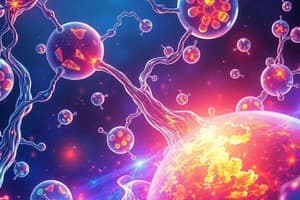Podcast
Questions and Answers
What is the primary purpose of the Light Dependent Reactions?
What is the primary purpose of the Light Dependent Reactions?
- To convert glucose into carbon dioxide
- To synthesize glucose from carbon dioxide
- To break down ATP into ADP
- To capture light energy and produce NADPH and ATP (correct)
Which organelle is responsible for the Light Dependent Reactions and the Calvin Cycle?
Which organelle is responsible for the Light Dependent Reactions and the Calvin Cycle?
- Chloroplasts (correct)
- Mitochondria
- Nucleus
- Endoplasmic Reticulum
During which stage is glucose primarily broken down, releasing ATP?
During which stage is glucose primarily broken down, releasing ATP?
- Light Dependent Reactions
- Calvin Cycle
- Krebs Cycle
- Glycolysis (correct)
How many ATP molecules are generated during the Electron Transport Chain?
How many ATP molecules are generated during the Electron Transport Chain?
Why do autotrophs perform both photosynthesis and cellular respiration?
Why do autotrophs perform both photosynthesis and cellular respiration?
What is the function of an enzyme?
What is the function of an enzyme?
Which statement correctly describes activation energy?
Which statement correctly describes activation energy?
In the equation A + B 🡪 AB, which components are identified as reactants?
In the equation A + B 🡪 AB, which components are identified as reactants?
What distinguishes an exergonic reaction from an endergonic reaction on the graphs provided?
What distinguishes an exergonic reaction from an endergonic reaction on the graphs provided?
What happens to an enzyme after it catalyzes a reaction?
What happens to an enzyme after it catalyzes a reaction?
Which of the following conditions could affect enzyme function?
Which of the following conditions could affect enzyme function?
Why is the lock-and-key analogy used to describe enzyme-substrate interactions?
Why is the lock-and-key analogy used to describe enzyme-substrate interactions?
How many total nitrogen atoms are present in the molecular formula for chocolate (theobromine) C7H8N4O2?
How many total nitrogen atoms are present in the molecular formula for chocolate (theobromine) C7H8N4O2?
Which of the following statements is true regarding the pH of tomato juice and soap?
Which of the following statements is true regarding the pH of tomato juice and soap?
What is the primary reason enzyme X does not function at 70ºC?
What is the primary reason enzyme X does not function at 70ºC?
What happens to enzyme activity when pH or temperature is altered from optimal conditions?
What happens to enzyme activity when pH or temperature is altered from optimal conditions?
In which organelle does photosynthesis occur?
In which organelle does photosynthesis occur?
What products are formed during cellular respiration?
What products are formed during cellular respiration?
How do autotrophs obtain their energy?
How do autotrophs obtain their energy?
In what way is ATP converted to ADP to provide energy to cells?
In what way is ATP converted to ADP to provide energy to cells?
Which independent variable could significantly affect enzymatic reaction rates?
Which independent variable could significantly affect enzymatic reaction rates?
Flashcards are hidden until you start studying
Study Notes
Chemical Reactions
- Reactants are substances that combine to form products.
- Enzymes are proteins that speed up chemical reactions by lowering the activation energy required.
- Activation energy is the energy required for a reaction to begin.
- Exergonic reactions release energy, while endergonic reactions require energy.
- The rate of a chemical reaction can be affected by factors such as temperature, pH, and the concentration of reactants and products.
- Enzymes have a specific active site that binds to a specific substrate.
- Temperature and pH can affect enzyme activity by changing the shape of the enzyme and its active site.
ATP
- ATP (adenosine triphosphate) is the primary energy carrier in living organisms.
- Energy is released when the bond between the second and third phosphate groups is broken, forming ADP (adenosine diphosphate).
Photosynthesis
- Photosynthesis is the process by which plants and other autotrophs convert sunlight energy into chemical energy stored in sugars.
- Photosynthesis takes place in chloroplasts and consists of two main stages:
- Light-dependent reactions: Capture light energy, release oxygen, and produce ATP and NADPH.
- Calvin cycle (light-independent reactions): Uses ATP and NADPH from the light-dependent reactions to convert carbon dioxide into glucose.
Cellular Respiration
- Cellular respiration is the process by which organisms break down glucose to release energy in the form of ATP.
- It takes place in mitochondria and consists of three main stages:
- Glycolysis: Occurs in the cytoplasm, breaks down glucose into pyruvate, and produces a small amount of ATP and NADH.
- Krebs cycle: Occurs in the mitochondrial matrix, completes the breakdown of glucose into carbon dioxide, and produces more ATP and NADH.
- Electron transport chain (ETC): Occurs in the inner mitochondrial membrane, uses NADH to generate a large amount of ATP.
Comparing Photosynthesis and Cellular Respiration
- Photosynthesis stores energy in sugars, while cellular respiration releases energy from sugars.
- Photosynthesis and cellular respiration are complementary processes that are essential for life.
- Autotrophs carry out both processes.
Studying That Suits You
Use AI to generate personalized quizzes and flashcards to suit your learning preferences.





